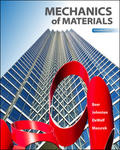
Concept explainers
(a)
Find the change in length of the cube in the x direction.
(a)
Answer to Problem 91P
The change in length of the cube in the x direction is
Explanation of Solution
Given information:
The modulus of elasticity in x-direction
The modulus of elasticity y-direction
The modulus of elasticity in z-direction
The strain along xz axis is 0.254.
The strain along xy axis is 0.254
The strain along zy axis is 0.428.
Calculation:
Write the stress to strain Equation along x direction as follows:
Here,
Write the stress to strain Equation along y direction as follows:
Write the stress to strain Equation along z direction as follows:
Equate the stress Equation along xy axis.
Equate the stress Equation along yz axis.
Equate the stress Equation along zx axis.
Apply the constraint conditions as follows:
Substitute 0 for
Substitute 0 for
Substitute
Substitute
Solving Equation to get values,
Apply the Equation (4) and (5) in Equation 1 as follows:
Substitute 0.254 for
Calculate the cross sectional area of cube as follows:
Here, a is the sides.
Substitute
Find the normal stress along x axis as follows:
Here, P is the tensile load and A is the cross sectional area.
Substitute
Find the strain along x axis as follows:
Substitute
Determine the change in length of the cube in the x direction using the relation:
Here,
Substitute
Thus, the change in length of the cube in the x direction is
(b)
The stress values
(b)
Answer to Problem 91P
The stress value
The stress value
The stress value
Explanation of Solution
Calculation:
Find the normal stress along x axis as follows:
Here, P is the tensile load and A is the cross sectional area.
Substitute
Thus, the stress value
Find the normal stress along y,z axis as follows:
Substitute
Thus, the stress value
Thus, the stress value
Want to see more full solutions like this?
Chapter 2 Solutions
EBK MECHANICS OF MATERIALS
- Sign in PDF Lecture W09.pdf PDF MMB241 - Tutorial L9.pdf File C:/Users/KHULEKANI/Desktop/mmb241/MMB241%20-%20Tutorial%20L9.pdf II! Draw | I│Alla | Ask Copilot + 4 of 4 | D TQ9. If motor M exerts a force of F (10t 2 + 100) N determine the velocity of the 25-kg crate when t kinetic friction between the crate and the plane are μs The crate is initially at rest. on the cable, where t is in seconds, 4s. The coefficients of static and 0.3 and μk = 0.25, respectively. M 3 TQ10. The spring has a stiffness k = 200 N/m and is unstretched when the 25-kg block is at A. Determine the acceleration of the block when s = 0.4 m. The contact surface between the block and the plane is smooth. 0.3 m F= 100 N F= 100 N k = 200 N/m σ Q Q ☆ ا الى 6 ☑arrow_forwardmy ID# is 016948724 please solve this problem step by steparrow_forwardMY ID#016948724 please solve the problem step by spetarrow_forward
- 1 8 4 For the table with 4×4 rows and columns as shown Add numbers so that the sum of any row or column equals .30 Use only these numbers: .1.2.3.4.5.6.10.11.12.12.13.14.14arrow_forwardMY ID# 016948724 please solve this problem step by steparrow_forwardThe pickup truck weighs 3220 Ib and reaches a speed of 30 mi/hr from rest in a distance of 200 ft up the 10-percent incline with constant acceleration. Calculate the normal force under each pair of wheels and the friction force under the rear driving wheels. The effective coefficient of friction between the tires and the road is known to be at least 0.8.arrow_forward
- 1. The figure shows a car jack to support 400kg (W=400kg). In the drawing, the angle (0) varies between 15 and 70 °. The links are machined from AISI 1020 hot-rolled steel bars with a minimum yield strength of 380MPa. Each link consists of two bars, one on each side of the central bearings. The bars are 300mm in length (/) and 25 mm in width (w). The pinned ends have the buckling constant (C) of 1.4 for out of plane buckling. The design factor (nd) is 2.5. (1) Find the thickness (t) of the bars and the factor of safety (n). (2) Check if the bar is an Euler beam. Darrow_forward(Read image)arrow_forwardUNIVERSIDAD NACIONAL DE SAN ANTONIO ABAD DEL CUSCO PRIMER EXAMEN PARCIAL DE MECÁNICA DE FLUIDOS I ............ Cusco, 23 de setiembre de 2024 AP. Y NOMBRES: ........ 1.- Para el tanque de la figura: a) Calcule la profundidad de la hidrolina si la profundidad del agua es de 2.8 m y el medidor del fondo del tanque da una lectura de 52.3kPa. b) Calcule la profundidad del agua si la profundidad de la hidrolina es 6.90 m y el medidor de la parte inferior del tanque registra una lectura de 125.3 kPa. Hidrolina Sp=0.90 Abertura Agua sup suge to but amulor quit y 2.- Calcule la magnitud de la fuerza resultante sobre el área A-B y la ubicación del centro de presión. Señale la fuerza resultante sobre el área y dimensione su ubicación con claridad. 3.5 ft 12 in: Oil (38-0.93) 14 in 8 inarrow_forward
 Mechanics of Materials (MindTap Course List)Mechanical EngineeringISBN:9781337093347Author:Barry J. Goodno, James M. GerePublisher:Cengage Learning
Mechanics of Materials (MindTap Course List)Mechanical EngineeringISBN:9781337093347Author:Barry J. Goodno, James M. GerePublisher:Cengage Learning
